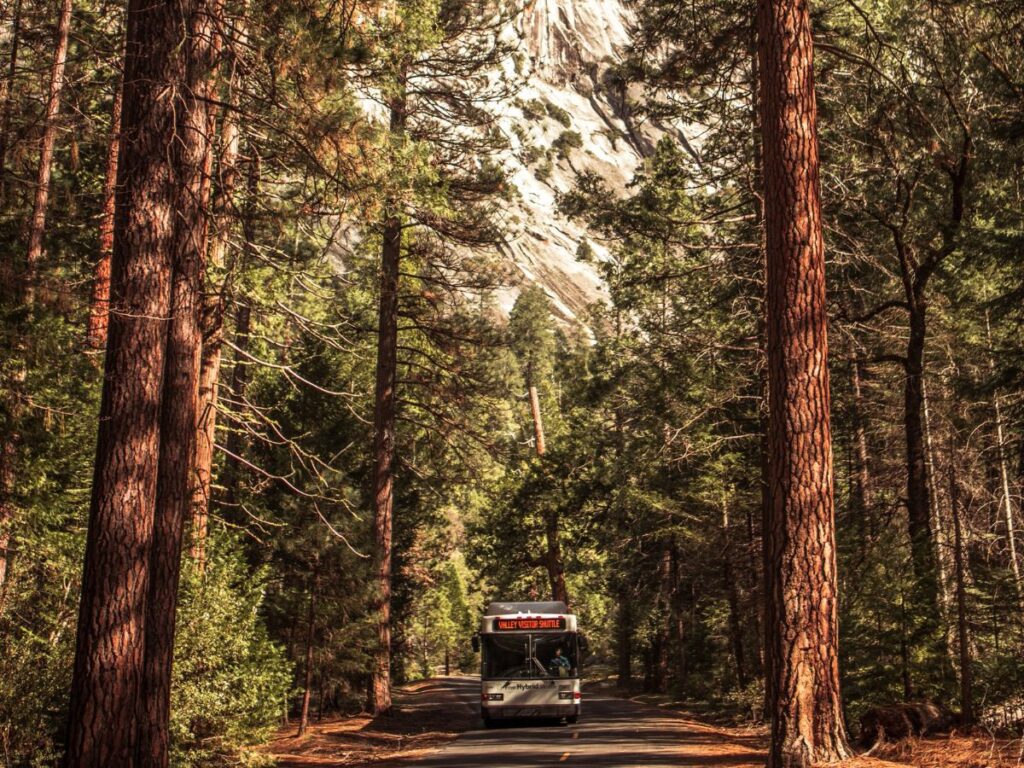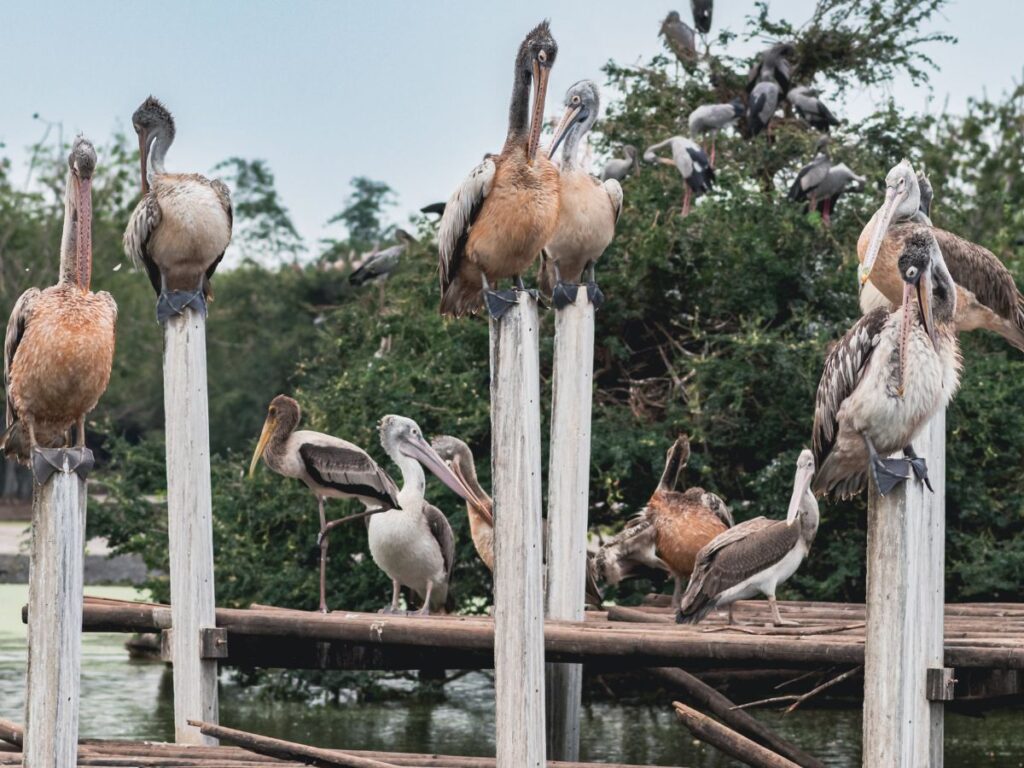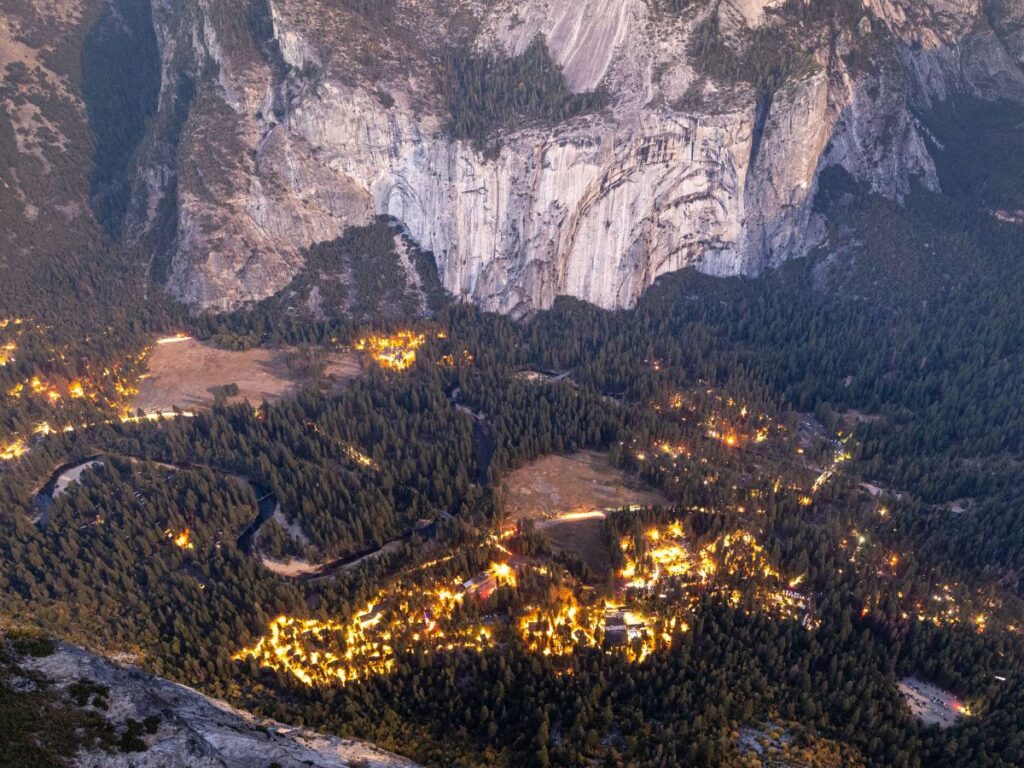Imagine a realm where granite cliffs kiss the heavens, waterfalls cascade like liquid silver, and ancient sequoias stand as timeless sentinels. Welcome to Yosemite National Park, a UNESCO World Heritage site, and nature’s masterpiece sculpted over millennia. Nestled in California’s Sierra Nevada mountains, Yosemite is more than just a park—it’s a testament to nature’s grandeur and the power of preservation. Whether you’re a history buff, an avid trekker, or someone seeking serenity, this park promises a journey of discovery. Dive into this guide and unveil the myriad secrets and stories Yosemite has to offer. Let’s embark on an exploration that’s as vast and varied as the park itself.
Location
Yosemite National Park is located in the Sierra Nevada mountains of California. Nestled within the towering expanse of the Sierra Nevada mountains in California, Yosemite National Park stands as a pristine testament to nature’s majesty. Its strategic location encompasses a diverse range of habitats, each a reflection of the region’s rich ecological tapestry. This park, set against the backdrop of snow-capped peaks and verdant valleys, remains a cherished destination for countless travelers seeking nature’s embrace.

Establishment
It was established as a national park on October 1, 1890. Commemorating its deep roots in the annals of American conservation, Yosemite was officially conferred the status of a national park on October 1, 1890. This landmark decision marked a pivotal moment in environmental preservation, safeguarding the park’s unique ecosystems and ensuring that its breathtaking beauty would endure for posterity.
Size
The park covers an area of 1,189 square miles (3,080 square km). Encompassing an impressive 1,189 square miles (3,080 square km), Yosemite National Park offers a vast realm of exploration. Within this expansive territory, visitors traverse a myriad of landscapes — from serene meadows and dense forests to rugged canyons and towering cliffs. Each inch of its vastness echoes the timeless narratives of nature’s grandeur and evolution.
Visitors
Yosemite attracts over 4 million visitors each year. Yosemite National Park, a magnet for nature enthusiasts and adventure seekers, sees a staggering influx of over 4 million visitors annually. Its unparalleled landscapes, ranging from tranquil valleys to robust mountain terrains, captivate the hearts of tourists from all over the world. The park’s accessibility and diversity make it a bucket-list destination, drawing crowds year after year.
World Heritage Site
In 1984, Yosemite was designated a UNESCO World Heritage Site. In recognition of its outstanding natural beauty and ecological significance, Yosemite was honored as a UNESCO World Heritage Site in 1984. This esteemed designation not only acknowledges the park’s global importance but also ensures its preservation for future generations, safeguarding its diverse habitats and historical landmarks.

Granite Cliffs
The park is famous for its dramatic granite cliffs. Yosemite’s dramatic granite cliffs stand as nature’s sculptures, carved by time and elemental forces. These awe-inspiring formations, soaring into the sky, are a testament to the geological history and raw power of the Earth’s processes. They not only define the park’s skyline but also attract rock climbers and photographers from across the globe, eager to engage with and capture their majestic beauty.
El Capitan
One of the most famous granite formations, El Capitan, is a favorite challenge for rock climbers. Dominating Yosemite’s skyline, El Capitan stands as a monumental granite edifice, renowned globally in the rock climbing community. Its sheer face, rising dramatically, presents an alluring challenge for climbers, beckoning the brave to scale its heights. Many climbers, from novices to professionals, dream of conquering this iconic formation, making it an emblem of human endurance and nature’s grandeur..
Half Dome
Another iconic granite monolith, Half Dome can be hiked via a cable route. Half Dome, with its distinctive silhouette, is another of Yosemite’s iconic granite landmarks. Its unique shape draws hikers from all corners, many of whom ascend its steep face using the famed cable route. This challenging trek rewards adventurers with unparalleled panoramic views, capturing the essence of Yosemite’s beauty.
Tallest Waterfall
Yosemite Falls is North America’s tallest waterfall at 2,425 feet. Cascading from a staggering height of 2,425 feet, Yosemite Falls reigns as North America’s loftiest waterfall. Its powerful descent creates a mesmerizing display of nature’s force, roaring in the spring and early summer. This magnificent cascade is not just a visual spectacle but also a testament to the park’s diverse topography and hydrological wonders.

Sequoias
The park is home to ancient giant sequoia trees. Within the verdant expanses of Yosemite National Park reside some of the Earth’s oldest living residents: the ancient giant sequoia trees. These towering behemoths, with their thick, reddish-brown bark and vast canopies, stand as silent witnesses to millennia of history. Representing the enduring spirit of nature, these age-old trees offer a humbling perspective on time and the wonders of the natural world.
Mariposa Grove
This grove contains about 500 mature giant sequoias. A sanctuary for the colossal and ancient, Mariposa Grove is a treasured enclave within Yosemite. Home to approximately 500 mature giant sequoias, this grove provides a mesmerizing display of nature’s grandeur. Wanderers amidst these giants often find themselves awestruck, encapsulated by the sheer magnitude and age of these venerable trees.
Wildlife
The park hosts over 400 species of vertebrates, including black bears and mule deer. Yosemite National Park is a vibrant tapestry of life, hosting an impressive array of over 400 species of vertebrates. Among the rustling trees and serene meadows, visitors might catch a glimpse of the park’s resident black bears, mule deer, and numerous other creatures. This rich biodiversity underscores the park’s ecological significance and offers a captivating window into the intricate web of life that thrives within its boundaries.
Biodiversity
It features diverse habitats, from chaparral and oak woodlands to subalpine zones. A mosaic of diverse ecosystems, Yosemite National Park stands as a testament to nature’s multifaceted splendor. From the dry chaparral and robust oak woodlands to the cooler climes of the subalpine zones, the park offers a medley of habitats. This rich ecological diversity not only provides refuge to myriad species but also paints a vivid portrait of the region’s natural history and evolution.

Tuolumne and Merced Rivers
Both originate within Yosemite’s borders. Cradling life and offering picturesque landscapes, the Tuolumne and Merced Rivers both have their genesis within the heart of Yosemite. These waters flow with stories of the park’s terrain, forging pathways through valleys and canyons, nourishing the land and its inhabitants, and underscoring the park’s hydrological significance.
Glaciers
Yosemite Valley was shaped by glacial activity. The iconic contours of Yosemite Valley bear the indelible marks of ancient glaciers. These colossal ice masses, moving with relentless force, sculpted the valley’s granite walls and shaped its floor. Today, the valley stands as a grand amphitheater, narrating tales of glacial might and the timeless dance of ice and rock.
Native Inhabitants
The Ahwahneechee people lived in the Yosemite region for centuries. Long before explorers and settlers ventured into Yosemite’s pristine wilderness, the Ahwahneechee people called it home. For centuries, this indigenous tribe thrived amidst the park’s valleys, forests, and rivers, forging a deep connection with the land. Their legacy, rich in cultural traditions and reverence for nature, offers invaluable insights into the region’s original stewards and their harmonious relationship with their surroundings.
Discovery
Non-native Americans “discovered” the area in the mid-19th century during the California Gold Rush. The allure of the California Gold Rush in the mid-19th century beckoned many to the state’s vast expanses. It was during this fervent quest for riches that non-native Americans “discovered” the captivating landscapes of the Yosemite region, casting new eyes on an age-old sanctuary.

Protection
In 1864, the Yosemite Grant was signed by President Abraham Lincoln, protecting the Mariposa Grove and Yosemite Valley – an early step toward its national park status. The significance of Yosemite’s natural splendor did not go unnoticed. In a pioneering act of conservation, President Abraham Lincoln signed the Yosemite Grant in 1864. This momentous decree shielded the Mariposa Grove and the iconic Yosemite Valley, setting a precedent for environmental preservation and paving the way for the establishment of the national park we revere today.
John Muir
The famous naturalist played a pivotal role in the establishment of Yosemite National Park. John Muir’s profound connection to nature and his unwavering advocacy for its preservation left an indelible mark on Yosemite’s legacy. The esteemed naturalist’s writings and activism spotlighted the unmatched beauty and ecological significance of the region. His relentless efforts, infused with passion and foresight, catalyzed the establishment of Yosemite National Park, securing its protection for future generations. His reverence for Yosemite remains an inspiration for conservationists worldwide.
Camp 4
This campsite is historically significant for rock climbing and was added to the National Register of Historic Places. Not just any campsite, Camp 4 stands as a testament to the evolution of rock climbing as a sport and a culture. Nestled within Yosemite, this iconic site has witnessed countless climbing milestones, nurturing legends and pioneering techniques. Recognizing its historical significance, Camp 4 was rightfully added to the National Register of Historic Places, immortalizing its place in climbing lore.
Hiking
The park offers over 800 miles of hiking trails. A hiker’s paradise, Yosemite unfurls a labyrinth of trails spanning over 800 miles. From gentle walks through meadows to challenging ascents up rugged peaks, the park’s trails cater to all. Every step promises awe-inspiring vistas, encounters with diverse flora and fauna, and a deep immersion into nature’s rhythm. The vast network invites adventurers to explore, discover, and connect with the wild heart of Yosemite.

Tioga Road
This is the highest highway pass in California and offers stunning views. Ascending to dizzying heights, Tioga Road claims the title of California’s highest highway pass. As travelers traverse this remarkable route, they are treated to breathtaking panoramas of Yosemite’s rugged landscape, alpine meadows, and crystalline lakes. Each twist and turn reveals a new vista, making the journey as memorable as the destination itself. Whether enveloped in summer’s green or winter’s white, Tioga Road offers an unparalleled scenic drive.
Hetch Hetchy Valley
Often compared to Yosemite Valley, this valley was dammed to provide water to San Francisco. Once echoing the natural grandeur of its sibling, Yosemite Valley, Hetch Hetchy Valley’s fate diverged when its pristine expanse was chosen to be dammed, creating a reservoir to quench San Francisco’s thirst. The decision sparked fervent debates on conservation, with proponents touting the benefits of water supply and detractors mourning the loss of a natural jewel. The valley’s submerged beauty remains a poignant reminder of the balance between nature and human needs.
Badger Pass
This is one of California’s oldest ski areas, located within the park. As winter’s embrace blankets Yosemite, Badger Pass emerges as a snowy wonderland, beckoning ski enthusiasts. Proudly wearing the badge of one of California’s oldest ski areas, it has been offering exhilarating downhill and cross-country experiences since the 1930s. Nestled within the park’s boundaries, skiers and snowboarders are treated to a unique blend of sport and wilderness, surrounded by Yosemite’s iconic landscapes.
Elevation
The park’s elevation ranges from 2,127 to 13,114 feet. Yosemite National Park showcases a staggering vertical tapestry, with elevations stretching from 2,127 feet at its lowest valleys to soaring heights of 13,114 feet at its mountainous peaks. This vast range in altitude creates a dynamic landscape where lush valleys coexist with rugged alpine terrains, offering visitors a spectrum of ecosystems and experiences as they navigate the park’s varied topography.

Climbing
Yosemite is considered the birthplace of modern rock climbing techniques. Synonymous with innovation in the world of rock climbing, Yosemite stands as the birthplace of many modern techniques that climbers worldwide rely on today. Pioneers of the sport, drawn to the park’s granite walls, honed their skills and developed new methods, transforming the approach to vertical ascents. As climbers challenge the formidable faces of El Capitan and Half Dome, they pay homage to a legacy that revolutionized climbing.
Bridalveil Fall
Another iconic waterfall, it’s often the first one visitors see when entering the valley. As visitors venture into Yosemite Valley, the ethereal mist and cascading waters of Bridalveil Fall often offer the first majestic greeting. Towering at 620 feet, this iconic waterfall enchants with its year-round flow, but it’s during spring when its might truly unveils, painting a powerful and unforgettable portrait of nature’s splendor.
Wilderness
About 94% of the park is designated wilderness, meaning no roads or buildings, and few trails. Reflecting nature in its purest form, a vast 94% of Yosemite National Park remains untouched by modern development. Designated as wilderness, this expansive area is preserved in its pristine state, free from roads, buildings, and only interspersed with occasional trails. Those who tread these wild paths experience nature’s raw beauty, away from the hum of civilization, offering a genuine communion with the earth as it once was.
Fire
Controlled burns are used to mimic natural forest fires and maintain the park’s health. In a symbiotic dance with nature, park officials employ controlled burns within Yosemite. These carefully managed fires replicate the cyclical role of natural forest blazes, rejuvenating the landscape and supporting the ecosystem’s overall health. By emulating nature’s rhythms, the park ensures that its diverse habitats thrive and remain resilient.

Black Bears
While black bears are commonly seen, there are no grizzly bears in Yosemite. Yosemite’s meadows and forests are often graced by the presence of black bears, an emblematic species of the park. These creatures, while awe-inspiring, are commonly sighted, offering a thrilling glimpse into wild America. However, visitors should note that the formidable grizzly bear is notably absent from Yosemite’s landscapes, emphasizing the distinct characteristics of the park’s fauna.
Granite Formation
The granite in Yosemite is around 100 million years old. Steeped in ancient history, the granite cliffs and formations within Yosemite National Park stand as silent witnesses to millions of years of geological evolution. Estimated to be around 100 million years old, this granite has endured countless epochs, shaping the iconic landscapes of Yosemite. Serving as the bedrock of the park’s monumental structures like El Capitan and Half Dome, this ancient stone tells a tale as old as time, beckoning visitors to ponder the inexorable passage of millennia.
Domes
Yosemite has many domes, formed due to exfoliation (shedding of outer rock layers). Yosemite’s landscape is punctuated with numerous domes, sculpted masterpieces of nature’s artistry. These rounded formations owe their unique appearance to the process of exfoliation, where outer rock layers successively peel away. This shedding, dictated by the forces of erosion and thermal expansion, has resulted in the park’s iconic dome-shaped granitic marvels. They stand as testament to the dynamic and ever-changing nature of Earth’s surface, constantly being reshaped by the forces that act upon them.
Meadows
The park features beautiful meadows like Tuolumne and Crane Flat. Nestled amid towering granite cliffs and dense forests, Yosemite’s meadows are havens of tranquility and biodiversity. Meadows like Tuolumne and Crane Flat paint the park with verdant hues, offering a contrasting landscape to the rugged mountainous terrains. These flat expanses teem with wildflowers, grasses, and wildlife, providing vital habitats and serving as serene spots for visitors to rest and revel in the park’s natural beauty. The meadows stand as gentle reminders of nature’s varied tapestry, beautifully woven in Yosemite’s vast expanse.

Glacial Features
Hanging valleys, tarn lakes, and U-shaped valleys in the park are all results of glacial action. Yosemite National Park boasts stunning topographical marvels, many of which are the legacy of ancient glacial activity. Hanging valleys, which seem suspended above main valleys, paint a picturesque scene. Tarn lakes, nestled in depressions carved by glaciers, shimmer serenely. And the U-shaped valleys, distinct from the V-shaped ones carved by rivers, stand as evidence of the immense erosive power of glaciers that once moved through them. Each feature offers a window into the park’s icy past, revealing tales of nature’s prowess and the passage of time.
Birds
Over 260 species of birds have been recorded in the park. As a sanctuary of biodiversity, Yosemite National Park is a haven for bird enthusiasts. With over 260 species of birds having graced its skies and forests, the park is a melodious symphony of calls, songs, and colors. From majestic raptors soaring above to tiny hummingbirds darting amidst flowers, the park offers a mosaic of avian life. Each species, whether migratory or resident, plays a crucial role in the park’s ecosystem, adding to the vibrant tapestry of Yosemite’s wildlife.
Horsetail Fall
In February, this fall can glow orange during sunset, creating the “Firefall” effect. In the heart of Yosemite, the Horsetail Fall presents a breathtaking spectacle each February. As the sun sets, its rays strike the cascading water in such a way that the fall appears to glow with a fiery orange hue, earning it the name “Firefall.” This ephemeral phenomenon, lasting only a few days, draws countless visitors and photographers. The surreal blending of fire and water, framed against a granite backdrop, captures the essence of nature’s magic and the ethereal beauty of Yosemite.
Caves
There are over 300 small caves in the park, formed by marble dissolution. Beneath the grandeur of Yosemite’s landscapes lies a hidden realm of over 300 small caves, carved out through the dissolution of marble. These subterranean wonders offer a glimpse into a world sculpted by water and time. The process, where slightly acidic water gradually dissolves the marble, has crafted intricate passages, chambers, and formations, making each cave a unique treasure trove of geologic artistry and subterranean ecosystems.

Lakes
Yosemite has numerous lakes; Tenaya Lake is one of the most picturesque. Among Yosemite’s diverse aquatic tapestries, its lakes stand out for their serene beauty. Of these, Tenaya Lake shines especially bright. Nestled high in the Sierra Nevada, its crystalline waters reflect the surrounding granite peaks and evergreen forests, creating postcard-worthy vistas. The tranquility of its shores and the clarity of its waters make Tenaya Lake an emblem of Yosemite’s pristine nature.
Subalpine Meadows
These host a diverse range of flora and fauna, particularly around the Tioga Pass. The subalpine meadows of Yosemite, especially those around the Tioga Pass, are ecosystems bursting with life. These high-altitude meadows are home to a myriad of flora, from delicate wildflowers to hardy grasses, and fauna that have adapted to the cooler climates. As summer blankets the region, these meadows become a riot of colors and activity, with pollinators busily visiting blossoms and animals foraging. The biodiversity and scenic beauty of these meadows underscore the ecological richness of Yosemite’s higher elevations.
Cultural History
The park showcases various historical structures, like the Ahwahnee Hotel and Parsons Memorial Lodge. Yosemite National Park, beyond its natural splendor, is a canvas of rich cultural history. Monuments like the Ahwahnee Hotel, with its stunning blend of Art Deco, Native American, and Arts & Crafts design, paint a picture of early 20th-century luxury. Elsewhere, the Parsons Memorial Lodge stands as a testament to the early conservation movement, a place where thinkers once gathered to discuss the ethos of preserving nature. Together, these structures and others contribute to a layered narrative of human interaction with the Yosemite landscape.
Camping
Yosemite has 13 popular campgrounds, with some being open year-round. For many, Yosemite’s essence is best experienced under a canopy of stars. The park boasts 13 campgrounds, each with its unique charm, catering to a variety of outdoor enthusiasts. Whether it’s the murmuring Merced River by Upper Pines or the towering pine trees of Hodgdon Meadow, campers find solace in nature’s embrace. With some campgrounds open year-round, the allure of Yosemite remains constant, be it under the warm summer sun or a blanket of snow.

Rockfall
Rockfall is a natural and common occurrence in Yosemite Valley. The imposing granite walls of Yosemite Valley, while majestic, are in a perpetual state of change. Rockfall is a routine geological event where rocks, sometimes massive in size, detach and plummet to the valley floor. Influenced by factors like weathering, earthquakes, and water, these events shape and sculpt the valley, underscoring the dynamic and evolving nature of the park’s geology. While awe-inspiring, they also serve as reminders of the raw, untamed force of nature at play in Yosemite.
Astronomy
The park offers nighttime stargazing programs for visitors. Under the vast canopy of the Yosemite night sky, stars sparkle with an unmatched brilliance. Yosemite National Park enhances this celestial experience by offering stargazing programs, drawing both amateur astronomers and curious visitors. Amid the natural darkness of the park, participants are treated to an orchestra of constellations, planets, and meteor showers. Expert guides help in weaving tales of ancient lore and scientific discoveries, turning a simple gaze upward into an enriching journey across the universe.
Snowshoeing & Cross-Country Skiing
Apart from skiing, visitors can also enjoy snowshoeing and cross-country skiing. Yosemite’s winter wonderland is not just confined to the delights of downhill skiing. The snow-blanketed landscapes beckon adventurers to explore in various ways. Snowshoeing offers a serene way to traverse the park’s quieter realms, leaving behind uniquely patterned tracks. For those seeking a rhythmic journey, cross-country skiing provides a harmonious blend of exercise and exploration, allowing visitors to glide through Yosemite’s pristine winter scenes. Both activities add layers of magic to the park’s frosty charm.
High Sierra Camps
These are a series of rustic camps connected by trails in the high country. Tucked away in Yosemite’s elevated terrains, the High Sierra Camps offer a blend of rusticity and adventure. These camps, strung together by winding trails, become waypoints for trekkers journeying through the high country. Each camp provides basic amenities, allowing hikers to lighten their load and immerse themselves in the surrounding alpine beauty. Their strategic locations offer panoramic vistas, making every stop a new chapter in a hiker’s High Sierra narrative.

Key Takeaways
- Yosemite is not just a natural marvel, but a tapestry of rich cultural and historical tales, from its indigenous inhabitants to its designation as a national park.
- Home to iconic granite cliffs, U-shaped valleys formed by glaciers, and over 300 caves, the park’s landscapes are both diverse and stunning.
- With its varied ecosystems, Yosemite provides habitat for over 260 bird species, elusive black bears, and ancient sequoias among other biodiverse species.
- Beyond sightseeing, the park offers numerous activities including hiking, rock climbing, stargazing, and skiing to immerse oneself in its beauty.
- Preservation is at Yosemite’s heart. From controlled burns to maintain forest health to wilderness permits ensuring sustainable trekking, conservation is key.
- Whether looking for campgrounds, safety tips, or seasonal highlights, Yosemite ensures an enriching and safe experience for its visitors.
- The park’s ethereal beauty has served as muse to many renowned artists, photographers, and writers, including the legendary Ansel Adams.
FAQs
- Are there any unique geographical features in the park?
Yes, it boasts iconic granite cliffs, U-shaped valleys from glaciers, and over 300 caves.
- How many bird species live in Yosemite?
Over 260 bird species have been recorded in the park.
- Can I see bears in the park?
Yes, black bears are commonly seen, but there are no grizzly bears in Yosemite.
- What’s special about High Sierra Camps?
They are a series of rustic camps connected by trails in Yosemite’s high country.
- Do I need any permits for an overnight stay in the wilderness?
Yes, wilderness permits are required for all overnight trips in the Yosemite Wilderness.
- What’s the best time to witness the “Firefall” effect?
The “Firefall” effect at Horsetail Fall can be seen in February during sunset.
- How old is the granite formation in Yosemite?
The granite in Yosemite is around 100 million years old.
